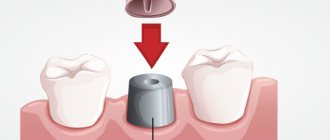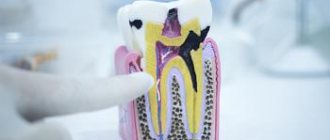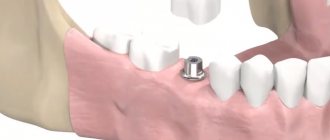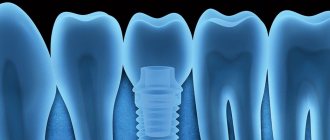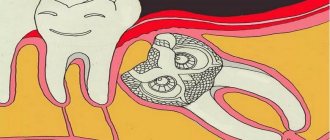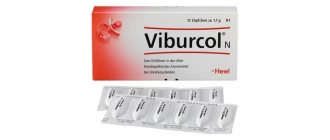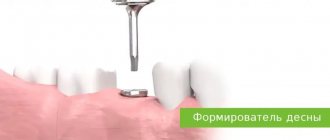As you know, dental implantation is not a cheap procedure. But this method is recognized by specialists and patients as the best of all existing methods of prosthetics. Therefore, if you are missing any number of teeth, it is worth choosing this one.
In this case, it is not necessary to install titanium root screws in place of each lost tooth. You can use quite effective budget options. The cost of a dental implant depends on the selected material and additional necessary doctor’s manipulations.
What to do if three teeth are missing in a row
Restoration of three consecutive missing units of the dentition can be carried out using:
- Installation of a bridge-like prosthesis supported by adjacent teeth - the defect is closed with an orthopedic design of crowns welded together. The outermost ones are attached to living teeth along the edges of the defect, which are previously depulped and ground down.
- Removable prosthesis - made of lightweight materials, used in cases of unsatisfactory condition of the supporting units, inability to withstand the load.
- Implantations - titanium rods are implanted into the jaw, acting as tooth roots, and covered with single crowns or a bridge.
Design Features
Butterfly prosthesis
is a small orthopedic structure for restoring 1-2 missing teeth. The prosthesis consists of the required number of artificial crowns, a small base and fastening elements - clasps. Clasps are small hooks made of plastic or metal that cover adjacent teeth or the alveolar process of the jaw and fix the structure in the oral cavity. It is thanks to its small size and the presence of hooks that the prosthesis was called a butterfly; the clasps resemble the wings of a butterfly. The product is also called an immediate denture, since it is used immediately after tooth extraction.
Butterfly is a very common method of replacing small defects in the dentition. The prosthesis is simple, inexpensive, accessible and comfortable. Therefore, it is used for temporary and permanent prosthetics. Of course, the product has its advantages and disadvantages, which the dentist tells the patient before treatment. The product is perfect for children and people with contraindications to implantation.
A butterfly prosthesis for a front tooth is the most inexpensive and easiest way to restore aesthetics and function. A well-chosen design is absolutely invisible to others. The disadvantage is the risk of the prosthesis shifting while eating, so you need to be careful and remember about the orthopedic structure in the oral cavity.
What is better - implantation or prosthetics?
A removable denture and a bridge supported on adjacent teeth are financially economical options, but they have a number of disadvantages:
- the jawbone underneath continues to atrophy, which leads to subsidence of the structure;
- the main load goes on the supporting teeth as a result of which they are destroyed;
- short service life - 5-7 years (for comparison, crowns on implants last 15 years or more, and titanium roots themselves last a lifetime);
- look unnatural;
- removable dentures cause discomfort due to the presence of an artificial palate, they press and rub;
- the presence of metal in the frame can cause an allergic reaction.
Bridge on implants
The ideal solution is to replace the full number of missing teeth with implants. But not everyone can “pull” its financial side. For such patients, experts offer a solution: install a bridge on implants. Such a decision becomes a reasonable compromise, and in certain situations it turns out to be the most rational option.
In this case, even before dental prosthetics, titanium “roots” are implanted. They are intended to serve as supports for the bridge structure, and their number will be less than the number of missing teeth. You also save on paying for the services of an implantologist, whose workload is reduced.
The procedure is carried out in three stages. First, a bed for the artificial root is prepared and a titanium implant is implanted. Then wait the allotted time until the healing process (osseointegration) is completed. This period varies for the lower and upper jaws and averages 3 and 6 months, respectively. After this period, supports for the prosthesis - abutments - are installed. After another time, a bridge is erected on top, which is made of metal ceramics or zirconium oxide.
How many implants need to be placed?
In the absence of three adjacent units of the dentition, the following are placed:
- 2 implants - are introduced along the edges of the defect, serve as support for a permanent bridge prosthesis consisting of three welded crowns (two of them are fixed to titanium roots, and the central one is hinged);
- 3 implants - replace each lost tooth and, after healing, are covered with separate crowns.
Which option will be chosen and which orthopedic structures will be used depends on the location of the defect.
Front teeth
Implantation of three adjacent incisors has a number of features due to increased aesthetic requirements:
- white zirconium abutments are used that are not visible through the gum;
- if necessary, plastic surgery of soft tissues is performed;
- smaller implants are selected for installation in the narrow bone of the frontal jaw;
- Crowns made of lightweight materials with bite relief are placed as temporary prostheses.
If three teeth in a row are missing from the front, both restoration options are suitable (2 and 3 titanium roots), however, the installation of three implants followed by prosthetics with single crowns is preferable. In this way, identity to natural teeth is achieved, an even gingival contour is formed, which guarantees maximum aesthetics.
Chewing teeth
When replacing three adjacent units of the lateral jaw, high demands are placed on the functionality of the structures. They must be securely fixed, withstand severe chewing loads, and prevent atrophic processes.
In such cases, we choose the option of installing three implants with single crowns, since a bridge on two titanium roots does not provide uniform pressure on the bone and leads to its resorption.
When implanting several teeth in a row, three or more, it is important to assess the condition of adjacent units. If they previously served as supports for a bridge, then, as a result, they are destroyed and cannot be restored - they will have to be removed and work with a more extensive defect.
Implantation of 3 teeth, E.max ceramic crowns
Attending doctor
Strigin Vladimir Igorevich
Find out the price
Indications and contraindications for production
A butterfly denture is made in the following clinical situations:
- Loss of 1-3 teeth in the front or side of the jaw;
- The need for prosthetics for 2-3 teeth;
- Partial edentia;
- Absence of a tooth by nature;
- Temporary replacement of a defect during the manufacture of a permanent structure;
- Inability to perform prosthetics using other prostheses;
- Presence of contraindications to implantation;
- Patient's wishes.
Contraindications to prosthetics are:
- Absence of more than 3 teeth in a row;
- Severe tissue atrophy;
- Periodontal diseases of adjacent teeth;
- Stomatitis, acute inflammatory processes in the oral cavity;
- Allergy to manufacturing materials (plastic, nylon);
- Deformation or defect of the alveolar process;
- Removal of the last molars, since their replacement is impractical.
Features of implantation on the upper and lower jaw
- When restoring three teeth on the upper jaw with the help of implants, the proximity of the maxillary sinuses and the infraorbital foramen is taken into account; on the lower jaw, the proximity of the mandibular nerve is taken into account.
- On top, due to less chewing load, the bone tissue has a looser structure, so the rods take 1-2 months longer to take root than on the bottom.
- Due to the fact that after the loss of the upper units, atrophic processes occur more intensely, in most cases, bone grafting has to be done before implantation.
- When choosing models of titanium roots for the upper row, the emphasis is on increased aesthetics, for the lower row - on functionality and resistance to chewing loads.
Prosthesis for 2 teeth: butterfly
If you are missing several teeth in a row and have no desire to walk around with gaps in your smile (while a permanent denture is being prepared), you should use a removable structure called a “butterfly” or immediate. This is a temporary structure that will partially restore chewing function and aesthetic appearance. This system is suitable for missing one, two or three teeth.
This method is recommended when:
- there is an urgent need to restore chewing function (food that is too hard is not intended for the “butterfly” and can damage it);
- it is necessary to preserve soft tissue after tooth extraction (as a result of this action, in the future there will be no need to build up this tissue in order to install a permanent one);
- Reconstruction of the integrity of a number of teeth is required in order to improve the aesthetics of the smile;
- it is important to replace missing teeth in order to preserve nearby ones (relevant for periodontitis);
- it is necessary to prepare soft tissues for installation of a permanent prosthesis.
Contraindications are situations when the structure simply cannot be installed. This happens if:
- the jaw bone is deformed (this can be either a congenital or acquired defect);
- there are no adjacent (supporting) teeth available.
Advantages of an immediate prosthesis:
- beautiful natural look;
- speed of production (a couple of days: the first visit - an impression is made, the second - installation of the prosthesis);
- hypoallergenicity of the material from which the structure is made;
- ease of care;
- possibility of use during gum disease;
- relatively low cost;
- impressive service life.
No matter how excellent this device is, it does not differ from the others in having a negative side. Its disadvantage is the fact that plastic clamps do not always hold the implant well, and this leads to the need to use metal clasps, which can ruin the aesthetics of the smile.
Operation stages
Preparatory
Includes x-rays of the dentofacial apparatus, sanitation of the oral cavity, examination of the patient to identify possible contraindications. At the same stage, a treatment plan is drawn up and future surgery is planned: rod models are selected, the position in the jaw is determined, and surgical templates are created. When the jaw bone is atrophied, the missing volume is increased. Preparation takes from several days to one month, with bone grafting - up to six months.
Installation of implants
It is performed under local anesthesia. The gingival mucosa is dissected, peeled off, and a hole is formed in the bone using cutters under each titanium root. After fixing the structures, the gums are sutured. This is followed by an engraftment period (up to 4 months on the lower jaw, up to 6 months on the upper jaw). At this time, a removable prosthesis made of lightweight materials can be installed to hide the aesthetic defect.
Prosthetics
Cover screws are removed from the implants and gum formers are placed in their place to create the correct gingival contour. Impressions are taken and transferred to the dental technician. After 1-2 weeks, the formers are replaced by abutments, onto which 3 single crowns or a bridge are fixed, depending on the type of prosthetics.
Operation and care
Hygienic care with a butterfly prosthesis is not complicated and consists of the following:
- The structure must be cleaned every day, but it can be removed periodically at night;
- In the evening, the denture should be removed and cleaned with a toothbrush and toothpaste or soap;
- Place the cleaned product in a glass of water or a special cleaning solution;
- You should brush your teeth as usual 2 times a day: morning and evening;
- Particular attention should be paid to the places where the prosthesis is fixed, where the clasps are attached to natural teeth;
- You should eat solid foods carefully; the butterfly may break if overloaded;
- After each meal, it is recommended to rinse the mouth;
- Once every 6 months you should visit the dentist for a preventive examination of the oral cavity and the integrity of the orthopedic structure.
The cost of the structure will depend on the material used, the number of missing teeth and the dental clinic. A prosthesis made of acrylic plastic will cost much less than one made of nylon.
How is bone grafting performed?
For reliable fixation of implants in the jawbone, it must be in sufficient volume. If teeth were lost more than 1 year ago, in 95% of cases bone tissue atrophy is diagnosed and bone augmentation is required (even if the defect was covered with a removable or bridge prosthesis). This is possible thanks to osteoplasty. In our clinic, the operation is performed using two methods:
- Sinus lifting is used for implantation of upper row dental units in the area of chewing teeth. A hole is formed in the bone, through which the bottom of the maxillary sinus is lifted with a special instrument, and the resulting space is filled with osteomaterial.
- Guided bone regeneration - performed on the lower jaw. It involves replanting missing units of bone material into the sockets and installing resorbable or non-resorbable protective membranes. The purpose of the membranes is to give the desired shape and volume to the area being grown, to isolate it from external factors, and to prevent deformation and resorption of the planted material.
For small bone deficiencies, osteoplasty can be combined with the installation of implants. The final decision is made by the doctor directly during the operation, assessing the risks and possible consequences.
As an alternative, a new technology may be proposed, the essence of which is to attach Keystone growth stimulators to the neck of the implant. After implantation of a titanium root into the jaw, the process of tissue regeneration around it is activated. The only disadvantage of the procedure is that it requires the use of expensive drugs.
Clasp prosthesis
The most popular method of treating adentia is clasp prosthetics. This is a removable structure that replaces missing teeth, restoring chewing function and smile aesthetics. This device is attached to natural teeth - supports. The entire load in such a device is evenly distributed between the supporting teeth and the gum.
Such a prosthesis is a base made of stainless metal, which is supplemented with plastic to create an imitation of soft tissue, and, accordingly, with artificial teeth.
The main advantages of the clasp system are:
- ease and high speed of adaptation (habituation);
- comfort in use;
- excellent load distribution during chewing;
- long service life (5-8 years);
- possibility to choose a fixation method: clasps (hooks), attachments (buttons), telescopic crowns;
- Possibility of use for periodontal disease and bruxism.
The disadvantage of this method is its cost and the inability to use it when there are no mounting bases.
Price
Our Center operates a case payment system, which guarantees patients no overpayments for additional services associated with implantation.
The implant installation case includes:
- cost of Nobel Biocare implants;
- doctor's work;
- consumables and superstructures;
- anesthesia;
- CT diagnostics before and after surgery;
- fixation of bone regeneration stimulators (up to 0.25 cm³) to the neck of the implant for simultaneous bone tissue growth in conditions of slight atrophy;
- antibiotics and painkillers at home;
- visits according to schedule.
The case for installing crowns and bridges includes:
- fixation of abutments;
- taking impressions;
- manufacturing, installation of crowns or bridges.
Sinus lifting and guided bone regeneration, if necessary, are paid separately.
Doctor's advice - crowns can be placed immediately
For this purpose, a one-stage implantation method is used, when an implant is placed and covered with a crown on top, without waiting for its engraftment. The method is used when there is a sufficient amount of bone tissue. Used for dental units that do not actively participate in chewing. The crown is placed temporary, made of plastic or metal-plastic, and removed from the bite (lower in height) to eliminate active loads. After engraftment, it changes to permanent.
Levin Dmitry Valerievich
Chief physician, Ph.D.
Average cost in Moscow
| Name of service | Cost in rub. |
| Turnkey implantation of 1 implant with classic installation | |
| Metal-ceramic crown | 39100 |
| All-ceramic crown | 50200 |
| Ceramic crown on special alloy | 60000 |
| Implantation with immediate loading | |
| Metal-ceramic crown | 58000 |
| Augmentation of bone material | |
| Implantation of osteoconductive material in the area of 1 tooth | 9600 |
| Closed sinus lift | 17700 |
| Open sinus lift | 36700 |
| Crowns | |
| Metal-ceramic | 20200 |
| From zirconium dioxide | 36700 |
| Bridge of 4 teeth supported by implants | |
| Temporary plastic crowns | 5200 |
| Made of metal ceramics on a cast frame made of a classic cobalt-chromium alloy | 40000 |
| Metal frame made by milling technology | 68000 |
| Metal ceramics on gold-platinum alloy | from 72000 |
Frequent arguments against double crowns and our answers to them
If something happens to one of the teeth and it needs to be treated or removed, all connected crowns will have to be removed
If it is necessary to treat one of the teeth under crowns, then this can be done through the crown, drilling a small hole in it, and then closing it with filling material. This is a completely acceptable technique and if everything is done correctly, such a crown will last for many years.
If one of the teeth under the crowns needs to be removed, it can simply be sawed off from the rest of the crowns and removed. But even if such a tooth were not connected to neighboring crowns, then most often the adjacent crowns would need to be redone. After removal, the gums sag significantly, and the edges of the crowns near the removed area no longer extend under the gums, and the tightness of the teeth under the crowns is compromised. And because of this, such a tooth can begin to deteriorate and gradually collapse.
With a double crown, it is impossible to clean between the teeth with floss (thread)
There is no need to clean the joint of the crowns with a thread, because nothing gets stuck there.
Connected crowns look unnatural
If crowns are made by a competent doctor and dental technician, then the connected crowns will look like free-standing ones.
What determines the number of implants when restoring 4 or more teeth?
- Condition of the jaw bone - when it is atrophied, it is not always possible to install the required number of rods. It will first be necessary to increase the missing volume.
- Type of prosthesis - for reliable fixation of permanent prostheses, a larger number of titanium roots will be needed than for removable structures.
- Financial situation - patients, wanting to save money, often ask to minimize the number of implants. You need to remember the possible consequences - damage to natural supports and breakage of the prosthesis, which will not have sufficient support.
The optimal number of rods is determined by the dentist, taking into account the general health and volume of the patient’s jawbone. The number of implants does not always exactly correspond to the number of units being replaced. In the absence of more than 10 elements of a row, installing 10 artificial roots is not justified from an economic point of view and is inconvenient for humans. It will be difficult for the body to get used to new designs.
When is multiple tooth implantation prescribed?
If two teeth are missing, it is usually necessary to install two implants. The fact is that if you install only one implant, the second tooth will be in limbo. He will create a cantilever, that is, a lever that will eventually dislocate this single implant from the bone. If the teeth are small and located close to each other, then in this case two mini-implants can be placed, thereby evenly distributing the load on both teeth. The total surface area of two such implants will be the same as that of one large implant. Therefore, two small implants are better than one large one with a hanging tooth.
What is implantation if several teeth are missing?
Alternatives to implantation
- Dental bridge - structures in the form of welded crowns are placed in place of missing teeth. Along the edges they rest on supporting living teeth, the middle pendant teeth replace lost teeth. The method has disadvantages - grinding and depulping of supporting units, the process of bone atrophy continues, short service life in comparison with implants - up to 15 years.
- A removable denture is an artificial gum with plastic crowns. It is attached to adjacent teeth with hooks or to the gums using suction. Under such prostheses, bone atrophy progresses with greater force. In addition, it is uncomfortable for a person to chew, and long-term addiction occurs. Service life - up to 7 years.
